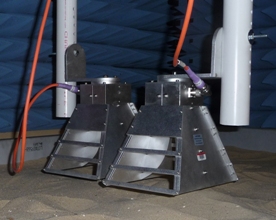
(June 26, 2009) - Department of Homeland Security (DHS) scientists want to help Border Patrol agents find tunnels with ground penetrating radar technology
Criminals of all kinds are digging tunnels along the U.S. border at a fast and furious pace. Sixty percent of all tunnels ever discovered by U.S. Border Patrol agents have been found in just the last three years. Agents spot a new one nearly every month, including an elaborate tunnel framed with wood studs, uncovered on June 10.
"All of them have been found by good law enforcement work or by chance," said Ed Turner, a project manager with the U.S. DHS Science and Technology Directorate (S&T). "None by technology."
S&T thinks that needs to change in order to battle these secret burrows in the 21st century. In a partnership with Lockheed Martin Advanced Technology Laboratories, S&T is pursuing a fresh approach that uses a sophisticated ground penetrating radar. The Tunnel Detection Project is part of the Homeland Security Advanced Research Projects Agency (HSARPA), an innovation leader that invests in concepts offering the potential for revolutionary changes in homeland security technologies. If successful, the technology will help agents locate and plug tunnels almost as fast as the criminals can dig them.
While most tunnels are used to smuggle drugs or people into the U.S., they could also be used to move in weapons and explosives for a terrorist attack. Tunnels are a serious challenge for Border Patrol agents because they can begin and end almost anywhere; their entrances and exits are often hidden inside old warehouses or under trees; if old ones are discovered, new ones are quickly begun.
Initially, S&T explored the possibility of an unmanned aircraft equipped with radar technology that would fly along the border searching for tunnels. While this concept isn’t off the table, scientists and agents both realize that most of the existing tunnels are concentrated in large urban centers where they are difficult to spot with satellite images. In addition, the airborne radar’s radio frequency signals could potentially pose privacy concerns if they cross into someone's home.
The new design is to place the radar antennas in a trailer towed by a Border Patrol truck. The antennas’ harmless electromagnetic waves penetrate the earth to construct a multi-colored picture of what’s below. Tunnels show up as red, yellow, and aquamarine dots against a blue background. Border patrol agents would see these images on a monitor mounted inside their truck.
The ground penetrating radar is a promising technology because it is already used by civil engineers to reconstruct underground images. But these engineers are usually only interested in detecting cables or pipes that may be a few meters beneath the earth. S&T needs to find tunnels that often run much deeper. To find these, the radar uses much lower frequencies that can penetrate the ground much deeper, and a sophisticated new imaging technology that can display clear pictures of deep tunnels.
The Lockheed team showed off an early scale model prototype this spring, mocking up the Southwest border with large box filled with sand and rocks, and using pipes as tunnels.
Next, they will send the technology to the Southwest this summer, where it will be tested against the rigors of the real life border. Separating tunnels from rocks, plants, and other objects on or buried shallowly in the ground will be a key test.
"We want to develop something highly reliable so agents can find tunnels and criminals, not other things in the ground," said Turner.
To request more information about any of these stories, please e-mail st.snapshots@hq.dhs.gov
